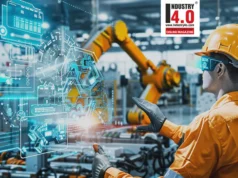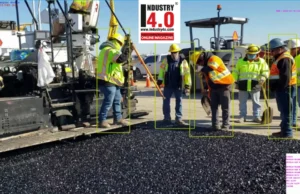Revolutionizing the Manufacturing Industry with Collaborative Robots
The presence of robots in speculative fiction and fantasy is nothing new. A robot-driven utopia in which humans and robots can live in harmony is within reach in the 21st century. Humans and robots can now coexist peacefully and harmoniously in a robot-driven civilization.
Companies in the manufacturing sector are frequently described as enthusiastic about the possible productivity gains that could be realized by implementing robotics. The industry has undergone profound change over the past few decades due to the introduction of cutting-edge technologies and groundbreaking innovations. Collaborative robots, or cobots, have witnessed enormous growth in popularity and use in recent years.
Cobots, or collaborative robots, are machines programmed to collaborate with human workers in an industrial setting. Smaller and simpler than conventional industrial robots, consumer-grade machines are also simpler to set up and operate.
Cobots‘ primary advantage is that they can function in a human-friendly environment without harming human workers. Cobots are designed to be utilized in the same workspace as humans without barriers or fences, whereas traditional industrial robots are generally segregated from human workers to prevent accidents. Thus, they may be more readily included in the production process, and cooperation between humans and robots can be improved.
Because of their potential to increase output quality and decrease production costs, cobots may also cause a major shift in the industrial sector. Robots can be set to operate nonstop without rest periods or holiday schedules, and they can be taught to execute a wide variety of jobs, from packaging to inspection to assembly. Because of this, factories may boost output while decreasing labor expenses.
Collaborative robots could dramatically improve production facilities by boosting productivity, cutting costs, and enhancing employee well-being. Several industries, including automobile manufacturing, electronics manufacturing, and the pharmaceutical industry, already use them, and that number is expected to rise in the coming years.
What distinguishes collaborative robots from standard industrial robots
Industrial robots are machines designed to do repetitive tasks in an industrial environment. Due to this, most devices on a factory floor are designed to perform a limited number of repetitive tasks. They are not typically intended to perform additional tasks like painting or stacking goods.
The components of an industrial robot are divided into three basic groups based on the functions they perform:
- Rack-mounted or mobile robot arms
- Articulated robot arms
- Wheel-drive robot arms
Most industrial robots consist of a rigid collection of elements that can only be moved in predetermined directions. This conventional method is particularly effective at completing a single task. It avoids making robot pieces mobile or detachable, but it may be prohibitively expensive when utilized for several jobs.
One of the primary goals in constructing collaborative robots is to make them as easy to program as feasible. It is accomplished by integrating flexible mechanical designs into unique assembly processes. Multiple robots can be easily integrated into a single assembly line. It can also assist the robot in adapting to changing client requests more effectively. This robot must be extremely adaptable to humans, and its environment’s machinery is another vital factor to consider. Currently, these robots can only perform tasks that people or other robots controlled by humans can perform safely.
The discovery of collaborative robots is a relatively recent development in robotics, and their popularity has exploded over the past several years. This technology is based on a fundamentally different and more adaptable approach to how robots function and interact with humans and other machines. Their programming capabilities and vast adaptability enable them to be utilized in various scenarios and applications. They may also be used to automate portions of production processes in addition to working alongside people. As a companion to conventional industrial robots, these devices are frequently utilized to execute complex, repetitive tasks that a human operator would otherwise perform.
One of the most distinguishing characteristics between collaborative and conventional industrial robots is their ability to function safely close to humans. Cobots are outfitted with sensors and software that enable them to detect and respond to the presence of humans. Additionally, they are designed to stop or slow down if they come into touch with a human, thereby reducing the danger of damage.
In contrast, normal industrial robots are often built to function in a separate, enclosed space and are not intended to come into contact with humans directly. They are often larger and more powerful than cobots and are utilized for jobs requiring greater force or velocity. In addition, they lack the same safety safeguards as cobots and may represent a larger danger of injury if they come into touch with a human.
The primary distinction between collaborative and ordinary industrial robots is their level of human engagement and safety features. Standard industrial robots are often utilized in separate, enclosed spaces and lack the same safety features as collaborative robots.
Advantages of Collaborative Robots
There are several advantages to using collaborative robots in a manufacturing or industrial setting. Some of the main benefits include:
- Increased productivity: Collaborative robots can work alongside humans to perform tasks more efficiently, which can help to increase overall productivity.
- Improved quality: Cobots are designed for tasks that require a high degree of precision, such as assembly or packaging, which can help improve the final product’s quality.
- Enhanced safety: Collaborative robots are equipped with sensors and safety features that allow them to operate safely close to humans, which can help to reduce the risk of injury in the workplace.
- Greater flexibility: Cobots are highly flexible and can be easily reconfigured to perform different tasks, which makes them well-suited to changing production environments.
- Lower cost: Collaborative robots are typically less expensive than standard industrial robots, making them more accessible for smaller businesses or those with limited budgets.
- Easier to implement: Cobots are generally easier to set up and program than standard industrial robots, making them a more accessible option for companies looking to automate their processes.
Disadvantages of Collaborative Robots
While collaborative robots offer many benefits, there are also some potential disadvantages. Some of the main drawbacks include the following:
- Limited power: Collaborative robots are generally not as powerful as standard industrial robots, which means they may not be suitable for tasks that require a high level of force or speed.
- Limited payload: Cobots are generally not capable of lifting as much weight as standard industrial robots, which may limit their use in certain applications.
- Sensitivity to the environment: Collaborative robots are equipped with sensors and safety features that allow them to operate safely close to humans, which can make them more sensitive to their environment. It may make them less reliable in harsh or dirty environments.
- Dependence on human supervision: Cobots are typically not as autonomous as standard industrial robots, so they may require more human supervision to function properly.
- Limited range of motion: Collaborative robots are generally not as agile as standard industrial robots, which means they may have a more limited range of motion.
Overall, the main disadvantages of collaborative robots are their limited power, payload, and range of motion, their sensitivity to the environment and their dependence on human supervision. These limitations may make them less suitable for certain tasks or environments.
Are collaborative robots more flexible than traditional industrial robots?
Yes, collaborative robots (cobots) are commonly regarded as more adaptable than conventional industrial robots. One of the primary advantages of cobots is their capacity to be easily reconfigured to perform various activities, making them well-suited for contexts with fluctuating production.
In contrast to traditional industrial robots, which are normally locked in place and programmed to execute specific activities, cobots may be reprogrammed quickly and do multiple jobs as needed. It makes them a more adaptable solution for firms that must adjust to fluctuating production demands or need to automate various jobs.
In addition to their task-performance versatility, cobots are typically easier to set up and program than conventional industrial robots. They frequently include software that allows even non-technical individuals to set the robot to execute a range of jobs fast and efficiently.
Is collaborative robotics on its way to our industries soon?
Even though many collaborative robots are now used for specific tasks, they are also applicable in other contexts, such as collaborative workgroups. As demonstrated, they can be combined with other systems to create full collaborative workgroups. Manufacturers can incorporate cobots into their companies’ existing functions, maximizing the use of existing resources.
According to the Robotics Industry Association (RIA), industrial robots are used worldwide to process materials, disassemble and weld components, inspect wiring and components, assemble and package parts, and do light assembly, among other tasks. These devices may also be used in all factory operations and other locations, such as warehouses and factories, to increase the efficiency and adaptability of organizations.
The cost of implementing more sophisticated technologies, which are perceived to be more flexible and practical in various company departments, as well as increasing productivity and decreasing the time required to complete multiple tasks, continues to be a challenge for many manufacturers, especially as they begin to implement more sophisticated technologies.
For instance, the cobot may be used for inspecting and quality control components, reducing the need for human labeling and examining characteristics, thereby making them safer, more precise, and more reliable than was previously feasible. It can also be used to inspect the assembly and quality of components, making the manufacturing process more efficient and straightforward. It will enable manufacturers to minimize quality control and process errors.
The cobot can also manipulate fragile components such as wafers without endangering the product. It was utilized, among other things, to reduce the number of errors caused by human handling and to increase the flexibility of the work environment, which had previously been an issue for Unitech.
Additionally, the number of required engineering hours, forklift truck movements, and maintenance costs are decreased, making this the most cost-effective way to increase a company’s production output drastically.
How are cobots changing the game for the manufacturing industry?
Cobots, or collaborative robots, substantially impact the industrial industry by increasing efficiency, upgrading quality, and boosting worker safety.
One of the primary advantages of cobots in production is their ability to work more efficiently alongside humans. Cobots are designed for operations requiring a high level of precision or skill, such as assembly, packaging, and material handling, and can boost the overall productivity of enterprises.
Cobots can increase the quality of the end product and enhance productivity. Since cobots are built for activities requiring a high level of precision, they can aid in reducing faults and enhancing the overall quality of the production process.
Another important advantage of cobots in production is their capacity to improve workplace safety. Cobots are outfitted with sensors and software that let them recognize and respond to the presence of humans, and they are designed to stop or slow down if they come into touch with a person. It helps to lower the risk of job injury.
The prevalence of collaborative robots is increasing. Because they operate independently and do not require specialist programming abilities, they make it easier for manufacturers to scale up production. A typical material handling operator utilizes collaborative robots approximately 33 percent of the time. These robots can be used for material handling, assembly, packing, product handling, and quality control. The benefit of collaborative robots for production is that they require fewer workers to operate. As a result, they are assuming responsibilities previously held by humans.
Depending on their history, employees may respond differently to artificial intelligence and digital technologies in the workplace. Most people believe that their employment is in peril and that their value to companies is declining. Long-term, artificial intelligence and other new technologies have the potential to empower humans and enable them to accomplish more with fewer resources.
The most profitable alternative is adapting to global competition through collaborative robotics and technology advancements. More than fifty percent of large businesses actively consider introducing collaborative robots.
Cobots are revolutionizing the industrial business by increasing efficiency, enhancing quality, and promoting worker safety. They are assisting firms in automating their processes and increasing efficiency, allowing them to remain competitive in the global market.
Bottomline:
Cobots, or collaborative robots, are designed to work securely alongside humans in a shared work environment. Common applications include assembling, packaging, and material handling, all needing high precision or skill. Cobots offer various advantages over conventional industrial robots, such as increased production, quality, safety, flexibility, and lower prices. In addition, they are typically easy to install and program, making them an attractive option for firms seeking to automate tasks. Cobots are already widely utilized in a range of industries, and their use is projected to increase in the future years as more and more companies seek to automate operations and increase efficiency.
About the author :

Mr. Sanjay Ahuja
Founder & CEO
cionlabs

● A tenacious technocrat with 26+ years of strong track record in Business Strategy and Transformation Programme, Advisory & Consulting, Practice Leader, Centre of Excellence, Program Management, Business Development and Alliances Management in the IT sector
● Recognized global expert and pioneer in the field of Robotics, Manufacturing, Intelligent Automation & Hyperautomation
● Passionate about making our world more human with Artificial Intelligence, Automation and Technology in general
● Advisory board member for Startp Incubator at Kurukshetra University Technology Incubation Centre KUTIC
● Chairperson Robotics IET Future tech panel India Chapter and driving the Robotics related initiatives
● Influencer, Mentor and Speaker with multiple sessions delivered to students and in different conferences.
● Enterprise Architect – Experience in designing complex enterprise architecture to solved business problems for large clients
● NewIT Enthusiast about Artificial Intelligence, Deep Learning, Machine Learning, Computer Vision, Natural Language Processing (NLP), Industrial IoT and AWS / Azure cloud computing IaaS / PaaS, Distributed Systems, Dockers
● Start-up Experience in setting-up Center of Excellence for Mobile as a startup at various organizations
● Business Growth – A strategic planner with proven ability to increase revenue, impact business growth and maximize profits through achievement in technical competency, internal controls, and efficiency improvements
Mr. Sanjay Ahuja Professional Experience :
https://www.linkedin.com/in/sa
Mr. Sanjay Ahuja is Bestowed with the following Licenses & Certifications :
https://www.linkedin.com/in/sa
Mr. Sanjay Ahuja Educational Details :
https://www.linkedin.com/in/sa
Mr. Sanjay Ahuja has completed the following Courses :
https://www.linkedin.com/in/sa
Mr. Sanjay Ahuja can be Contacted at :
Email : [email protected]
LinkedIn : https://www.linkedin.com/in/sa
Twitter : https://twitter.com/SanjayAh
About Cion Labs :
Cion Labs is formed by a group of experts with extensive domain knowledge coming from the leading technology and consulting firms around the globe with the aim to deliver The Best in the industry. We have the capability to develop comprehensive solutions to tackle the industry challenges, creating value, improving profitability and sustainability for our customers.
Cion Labs is a young startup providing full-stack product engineering services to MSME. We help customers with consulting services, product design, and development to enhance their digital experience, improve revenue, and achieve operational excellence.
We have deep industry knowledge, a talented workforce, and innovative solutions around Smart Embedded Products, IoT, Cloud, Automation, Mobility, AI/ML, Computer Vision, and Additive Manufacturing.
To Contact Cion Labs :
E mail : [email protected]
Website : https://cionlabs.com/
LinkedIn : https://www.linkedin.com/compa
Twitter : https://twitter.com/CionlabsC
Youtube : https://www.youtube.com/channe
Instagram : https://www.instagram.com/cion










